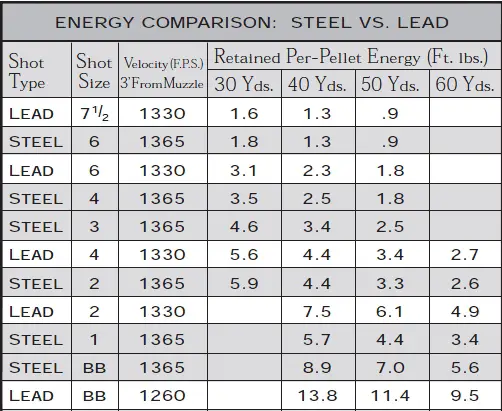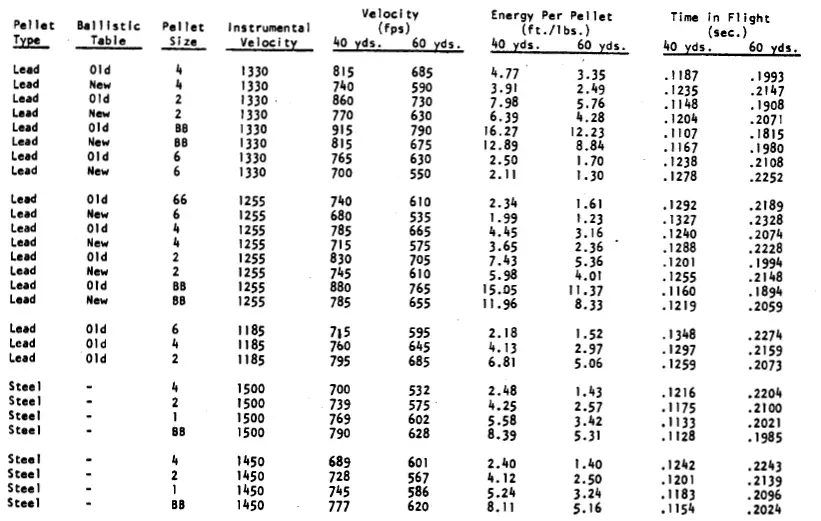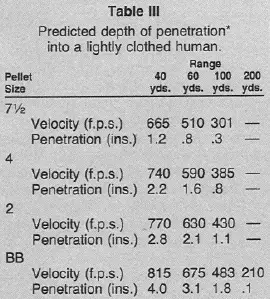


Steel Versus Lead in Shotshells: Mythbusting
There is a huge collection of not just conflicting, but clearly bad information about steel shotshell performance and lead shotshell performance. Most of the unusable information has been perpetrated by shotshell and shotgun manufacturers alike. Though this subject matter isn't of interest to everyone, perhaps it should be.
MYTH #1: Today's Steel Loads Are Improved
You'll hear again and again how much improved “modern” steel loads are compared to the old ones. Much of the truth of it (or lack thereof) is contingent on what is meant by “old” steel loads. The old steel load comparisons were fairly ancient. It isn't a matter of steel shotshells within the last few years or even the last decade or even the last 20 years. The Belrose testing was from 1959, the Mississippi Flyway Council conducted in 1969 at Nilo, and the Winchester-Western testing at Nilo was from 1972-1973 to cite but a few examples.
One of the problems was that the commonly accepted exterior ballistics for shot were wrong. No one seemed to know where they came from. They were always wrong and still are today. It was in 1970 when Ed Lowry completed the corrected tables for SAAMI, tables that have not been incorporated to this day.
The corrected ballistics were neither pro-steel or pro-lead. As it turns out, the lead tables were way off, making lead look far better than it really was downrange. At the same time, the superior sphericity of steel shot and resultant better form factor was also ignored. It still is today. The “old” steel loads that gave decidedly bad performance were the commercial loads from the mid 1970s. So, you have to go way back. Current SAAMI steel shotshell standards were published in 1992, twenty years ago, and nothing has changed since from a specification standpoint.
MYTH #2: “The Rule of Two”
Studies have been counter-intuitive. “After bagging 300 birds, researchers declare that No. 2 is best steel shot size for Roosters” was the declaration from Craig Bihrle, communications supervisor for the North Dakota Game and Fish Department, in 1999. That study ignored lead, focusing only on steel loads, and 1 ounce 12 gauge steel loads at that. Nevertheless, it was a thorough study by most standards, No. 2 steel being more effective at ALL ranges over #4 and #6 steel as the major finding derived from this two-year study of steel shot performance on pheasants. The test, conducted in fall 1997 and 1998 by the Cooperative North American Shotgunning Education Program (CONSEP), designed and administered by independent shotshell ballistics expert Tom Roster, compared the capabilities of three different steel shot loads for taking ring-necked pheasants. The U.S. Fish and Wildlife Service, North Dakota Game and Fish Department, and South Dakota Department of Game, Fish and Parks funded the test.
It raised more questions than it answered. One ounce of #2 steel is about 125 pellets, a poor pellet count compared to the standard 1-1/4 oz. loads of #6 lead (281 pellets) and #5 lead (212 pellets). A lousy 50% 40 yards pattern of the common #6 lead is more pellets than a 100% 40 yard pattern of #2 steel. Even today, the common advice is “just go two sizes larger with steel and let her rip.” If you believe that #5 lead is good pheasant medicine, then the rule of three is more accurate than the “Rule of Two.” If you are persuaded that #6 is fine for pheasants, perhaps now it is the “Rule of Four.”
The pheasants shot were reportedly 3 lb. birds, but they weren't wild birds, either . . . all pen-raised, released birds. From the North Dakota Outdoors article, “Of all birds struck with the No. 2 steel load, 108 were retrieved and 10 were lost, an 8.5 percent wounding loss rate. No. 6 steel produced a 13.6 percent wounding loss, and No. 4 steel came in with a 14.3 percent wounding rate. Interestingly, hunters lost only two of 68 birds hit at distances of less than 30 yards with all three loads combined, a wounding rate of 2.9 percent. All test loads together produced 15.1 percent wounding loss at shot distances of 40 yards or greater.”
The article continues, "Known scientifically as the abdominal and dorsopelvic feather tracts, these feathers at the extreme rear of a pheasant were frequently found to ball up or wrap around pellets as they punctured the skin and to significantly impede a pellet's ability to penetrate. The feather-balling problem was most prevalent in No. 6 steel shot, affecting well over 50 percent of pellets in bagged birds. No. 4 steel had slightly less feather-balling than 6s, while No. 2 steel was found to have significantly lower occurrence."
Overall, when all pellets that struck pheasants were measured, No. 2 steel "had a significantly higher mean depth of penetration and percentage of pellets that penetrated all the way through and exited the bird, than did the other two loads. No. 2s also had a significantly higher incidence of breaking wing and leg bones they struck. For pheasants prone to run when wounded, a broken leg can mean the difference between a bagged or lost bird." Tom Roster and his team necropsied all 324 bagged pheasants. The shells used were 1375 fps 2 3/4-inch 1 oz. payload factory Remington 12-gauge loads.
You might think that studies like this, funded with tax dollars, would be readily available and accessible to everyone. After all, if it is important enough to use Federal and State dollars for it, are not citizens entitled to the results? Oddly, not much is readily available. Billed as the "first-ever scientific test of shotshell efficiency on ring-necked pheasants," for dubious reasons, lead shotshells were ignored, as were the more logical 1-1/8 oz. and 1-1/4 oz. #2 steel shotshells, still having an anemic pellet count compared to traditional lead pellet loads: #5 lead 1-1/4 oz. equating to about 215 pellets, same payload of #2 steel just 155 pellets.
MYTH #3: Shot Ballistics

Even though the long accepted shot ballistics have been shown as false over forty years ago, the same incorrect information is still published and republished like gospel from most manufacturers, just as shown above. If the information has no value, why release it in the first place? If it is known to be wrong, what excuse is there for not correcting it? The old ballistics tables showed that #4 lead shot with a 1330 fps 3 ft. muzzle velocity was still travelling 815 fps at 40 yards, with 4.77 ft. / lbs.of energy retained. A current manufacturer's chart (above) states 4.4 fpe at 40 yards. Lowry, back in 1970, showed 3.91 fpe at 40 yards.


In the October, 1988 issue of the American Rifleman, Ed Lowry discussed the history and the current state of the art in the "Shot Penetration in Soft Targets" article, as above. Yet again, you'll see 740 fps at 40 yards as the residual velocity of a 1330 fps #4 lead pellet, not the old 815 fps value. Even though SAAMI recognized the problem with shot ballistic tables, authorized and funded the research back in 1969, all this was never disseminated properly and still has not been today. Even well-respected sources, such as Lyman's Shotshell Reloading Handbook, 4th Edition (Copyright 1998), shows the old, wrongful data (see pages 128-130).
MYTH #4: "Dead is Dead."
At first blush, that might sound about right. Regardless of poor shotshell or choke selection, it all is quickly rationalized when a duck is managed to be dropped. It is just as bad and as pointless as trying to read a break on a clay pigeon. There is feed the coyote type of dead and then there is the feeding your family type of dead. The goal, of course, is not just dropping a duck like rain or any other colorful but nonsensical tag line. It isn't about dropping at all, the actual goal is about 100% game recovery. We are all not exactly trained observers when it comes to our own shots. Often, stuff gets hit that isn't noticed and our recollection of range is a very long ways from exact. When we have studies like the 324 pheasant test already cited, with generally solid data and professional autopsies to boot, it gets ignored. It is hard to accept that the relatively low pellet count one ounce #2 steel shotshell load was more effective than #4 or #6 steel at all ranges, but that was the very clear conclusion.
#5: "What Is Not a Myth"
What is not a myth is that pattern consistency varies all over the place based on choke and shell. Factory choke tubes, to this day, are largely vendored-out items, something like the highest quality from the lowest off-shore bidder . . . a tenuous and rare event. Mis-marked choke tubes are so very commonplace, it seems like a new adventure with every batch of new shotguns that I test.
Consistency and repeatability equates to both accuracy and lethality. There is also pressure to market cheap shotshells, and knowing that so few people cut open shotshells to check basic things like diameter consistency and sphericity, few people bother to pattern their guns, manufacturers of course give folks what they claim to want: cheap ammo, cheap chokes, and so forth.
Marketing collides with what has been established. We know that perfectly spherical pellets handily outperform odd shaped pellets. We also know that higher density materials handily outperform lighter, less dense shot materials. Both known facts are ignored. Not just in steel shotshells, but in lead shells as well.
The better-performing lead shells have more costly high-antimony shot that is consistent in diameter and sphericity. In addition to that, buffering lead loads helps dramatically to keep what starts as spherical, spherical. Soft lead loads with a collection of different diameter pellets of irregular shapes don't do well. Bad lead loads can be just as bad as anything else.
At the same time, despite better patterning efficiency of spherical shot and less downrange velocity erosion, odd-shaped steel and lead loads are marketed heavily and sold as "premium loads." No one in their right mind would bother with Black Cloud, Prairie Storm, or the worst of the lot: Blind Side, based on a rudimentary understanding of what is known and has been shown. You don't have to be out of your mind to be interested in shotshell effectiveness, but it seems to help. With the effectiveness of #2 steel low pellet count 2-3/4 in. 1 ounce loads, the 3-1/2 inch chambered shotguns we waste our money on look more ridiculous all the time, particularly if used with non-spherical shot, dubious vendored OEM choke tubes, and shell / choke combinations that have never been patterned.
The good news is that if you focus your efforts on the proper combination of a quality choke tube in terms of strength, materials, concentricity, and overall machining quality along with a shotshell that produces consistent velocities with spherical shot of the same diameter, you'll have a more effective shotgun. Use higher-density shot materials, you're better off yet. That is just as it should be.
Copyright 2012 by Randy Wakeman. All Rights Reserved.

Custom Search

Custom Search



